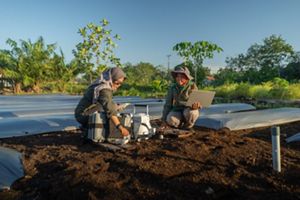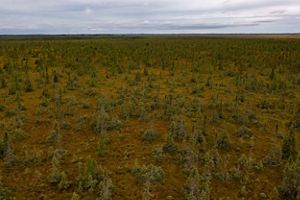Natural Climate Solutions
Natural climate solutions offer immediate and cost-effective ways to tackle the climate crisis—while also supporting healthy, thriving communities and ecosystems.

Leather Leaf Found throughout Sax-Zim Bog, leather leaf is a characteristic peatland plant. © Alora Jones/TNC
Peatlands are irreplaceable. These ancient wetlands take thousands of years to form, building up inch by inch with layers of decaying plants. Peatlands hold the carbon and stories of our past and are key to a livable future. They can be found all over the world in 180 countries and hold special cultural significance for many Indigenous communities, who are important peatland stewards. Healthy peatlands support many unique, endemic and threatened species, help filter drinking water and lessen flood risks by acting like a sponge.
Protecting and rewetting peatlands are powerful actions in the fight against climate change, helping to slow its progression while also shielding communities from its worst impacts by reducing the risks of floods, droughts, and fires.
Composed of layer upon layer of peat soil, or partially decayed plant matter that has accumulated over thousands of years, peatlands are a type of ancient wetlands found all over the world. Bogs, swamps, and fens are all types of peatlands.






West Kalimantan, Indonesia: Indonesia is a critical hotspot for peatlands, home to about a third of total tropical peatland areas. © YKAN

Ancient Soil: These ancient wetlands take thousands of years to form, building up inch by inch with layers of decaying plants. © Sydney Bezanson/TNC

Northern Bog, Minnesota: Healthy peatlands provide water security, sustain local livelihoods and fisheries, support unique plants and animals, and curb floods, droughts, and fires. © Derek Montgomery

Sphagnum Moss: One common family of plants you’ll find in peatlands is sphagnum mosses, which include hundreds of different species. © Derek Montgomery

Colombia's paramos: Peatlands store irrecoverable carbon, that is carbon we can’t recover in time to avert the worst impacts of climate change, since it took thousands of years to accumulate. © Sebastian Di Domenico
No results are shown. To see results, turn on the toggle switches in the legend.
TNC is mapping the largely undocumented peatland ecosystems in the Upper Okavango Basin of Angola. Our goal is to protect this vital carbon sink for climate progress, while supporting local communities and preserving biodiversity.
TNC is implementing a 5,000-acre nature-based solutions project that strategically rewets Delta peat soils at Staten Island in California, through a combination of rice cultivation and wetland restoration – practices that reduce GHG emissions, stop and reverse land subsidence, and create high-quality habitat for migratory birds.
In Colombia, TNC researchers conducted a two-year study about Colombia’s paramos (an important type of peatland in the region). Their findings – about how the paramos store carbon and the value to the local economy – will help the country’s government better incorporate peatlands into their NDC as part of the Paris Climate Accord.
In Chile, a partnership with Universidad Bernardo O’Higgins is helping to establish sustainable practices for harvesting Sphagnum moss. Together with local communities, the project promotes gender-responsive, sustainable livelihoods that align with long-term conservation goals. Moreover, TNC co-led the development of the Conservation Plan for the Torres del Paine Biosphere Reserve.
In Indonesia, our local affiliate, YKAN, is leading science in Kalimantan to demonstrate the value of peatlands in tackling climate change. And they are developing community-led peatland conservation strategies that help lessen fire risks and support sustainable livelihoods like fishing.
In Minnesota, TNC scientists have developed a “Peatlands Playbook,” which will give conservation practitioners in the state the technical guidance they need to protect healthy peatlands, rewet partially drained peatlands, and restore fully drained peatlands.
In Mongolia, TNC works with traditional nomadic livestock herding communities to protect peatlands. These communities are important influencers of sustainable use of peatlands, which are tied to their livelihoods, seasonal grazing, and water regulation.
TNC, in collaboration with the New Jersey Department of Environmental Protection, Division of Fish and Wildlife and other partners, has embarked on an effort to improve habitat within the approximately 1,200-acre "Hyper Humus" section of the Paulinskill Wildlife Management Area.
Despite their benefits, over 90% of New Zealand’s wetlands have been altered through a change in land use. TNC New Zealand is exploring whether peatland restoration projects could access sustainable financing for nature restoration via teal carbon credits.
TNC has restored peatlands across the coastal plain. We are currently working to restore 33,000 acres and protect 10,500 acres of peatlands in NC and VA. We've developed a first-of-its-kind methodology to quantify the emission reductions gained from restoring coastal peatlands, enabling landowners to access market incentives for peatland restoration across the region.
TNC is working across Patagonia to protect and sustainably manage peatlands. This initiative aims to avoid impacts on 3 million hectares of wetlands and reduce greenhouse gas emissions by up to 15.6 million tons of CO₂ equivalent per year by 2030. The project also seeks to benefit up to 100,000 people, with a strong focus on gender equity, capacity building and community leadership.
In just a sliver of earth’s surface, water, carbon, and cultural traditions run deep.
Though they only cover 3% of the Earth's surface area, peatlands play an outsized role in the carbon and water cycles.
Peatlands store 10% of the planet's unfrozen freshwater, making them critical for healthy communities.
Globally, peatlands store one quarter of the Earth's soil carbon — more carbon than in the world's forest biomass.
In some cases, agricultural subsidies create incentives to drain them and convert the land to other uses, like palm oil plantations. Human-caused fires, pollution, harvesting for the horticulture industry and melting permafrost also threaten peatlands
These degraded peatlands contribute up to 5% of anthropogenic greenhouse gas emissions – but this can be reversed when peatlands are rewetted.
Our actions over the next decade will determine whether peatlands become a significant climate liability or a vital part of the climate solution. We can save these critical ecosystems by combining the best available science and traditional ecological knowledge, partnering with Indigenous people and local communities, and deploying peat-positive finance to peatland stewards.
In just a sliver of earth’s surface, water, carbon, and cultural traditions run deep. Peatlands hold the carbon and stories of our past and are key to a livable future.
TNC can contribute significantly to global peatlands action: with our global leadership in NCS and our existing peatland initiatives in many key geographies, we can exchange learnings across global peat networks to accelerate action. With local to global connections, we combine deep, on-the-ground experience and relationships with expertise in innovative finance, policy, science, and communications, to enable transformational systems change.
We envision peatland communities stewarding healthy peatland ecosystems, sustaining local livelihoods while maintaining peatlands’ multiple benefits for climate, nature, and people.
No, peatland restoration and protection alone cannot solve climate change, as these and other natural climate solutions must be paired with phasing out fossil fuels and accelerating renewable energy.
However, peatlands are vitally important for meeting the climate targets outlined in the Paris Agreement and helping ensure a livable planet.
Yes, healthy peatlands release a bit of methane—but when they are left alone, they hold a lot more than they release.
Healthy peatlands that naturally release some methane due to low oxygen in the soil remain a net carbon sink in the long term. If disturbed, peatlands release this stored methane, contributing to 10% of global methane emissions.
Carbon is stored in peat, and it is emitted as either CO2 or CH4 depending on whether oxygen is available. When peatlands are drained, this decreases anaerobic decomposition (reducing methane emissions), while increasing aerobic decomposition (increasing CO2, and N2O, emissions). The effect (of lower CH4emissions but higher CO2and N2O emissions) is substantially higher net GHG emissions after drainage.
The primary threats to peatlands are human actions to drain or harvest peat, and climate change.
In some cases, agricultural subsidies create incentives to drain them and convert the land to other uses, like palm oil plantations. Human-caused fires, pollution, harvesting for the horticulture industry and melting permafrost also threaten peatlands.
Peatlands in Europe have been impacted by humans for centuries, including via peat extraction for fuel and extensive drainage for agricultural use. In Canada, infrastructure development and large-scale mining is a major threat. Peatland degradation in Southeast Asia has been driven principally by industrial scale agriculture and plantation establishment. Petroleum and mineral exploration have the potential to substantially degrade peatlands in the Congo Basin and Peruvian Amazon.
Climate change also poses major risks to peatlands and their carbon stocks. Fire and sea level rise are threatening peat areas across all biomes. Warmer temperatures and changes in precipitation will lead to GHG emissions from peatlands. Permafrost thaw is an increasing risk unique to high latitude peatlands, jeopardizing substantial carbon stocks.
Yes—bogs and fens are types of peatlands. Some, but not all, swamps can be peatlands.
Around the world, peatlands have different names. For example, the paramos ecosystem of Colombia contains peatlands.
Access the latest reports, tools & in-depth thinking on real-world solutions to climate change, water security, biodiversity, and human health.

Science shows that—combined with cutting fossil-fuel use and accelerating renewable energy—natural climate solutions can help us avoid the worst impacts of climate change.